Many Michigan Technological University students at this moment are trying to decide what to do after graduation, and a common question is: graduate school or a job? But, Nathan Sankary, who graduated from Michigan Tech last spring, added another layer of complexity to the question: Could he complete more schooling in a country where he did not know the language, one that is riddled with turmoil over the Western perspective of their international political problems?
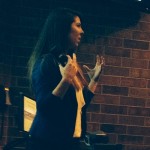 Hannah White, public outreach manager at Northwest Mining Association, a national nonprofit, nonpartisan trading association representing the entire mining life cycle, from exploration to reclamation and closure. Their purpose is to advocate and advance, educate, and foster and promote environmentally and socially responsible mining. She spoke to students in a seminar on November 19th. More info
Hannah White, public outreach manager at Northwest Mining Association, a national nonprofit, nonpartisan trading association representing the entire mining life cycle, from exploration to reclamation and closure. Their purpose is to advocate and advance, educate, and foster and promote environmentally and socially responsible mining. She spoke to students in a seminar on November 19th. More info
 The National Mining Competition announced the three winners from the 2013 event. First place Michigan Tech, second place University of British Columbia, and third place Edwards School of Business.
The National Mining Competition announced the three winners from the 2013 event. First place Michigan Tech, second place University of British Columbia, and third place Edwards School of Business.
The winning Michigan Tech Mining team, “the fabulous four,” was Cora Hemmila, Matthew Younger, Matthew Schuman and Matthew Schwalen. The team advisor is James Murray Gillis, Instructor, Geological and Mining Engineering and Sciences, Director, Mine Safety and Health Training Program.
 Nathan Sankary, who graduated in geology from Michigan Tech earlier this year, is doing Master’s degree work in Israel this year at the Israel Institute of Technology studying Environmental Engineering. He was raised in Minneapolis and earned a Michigan Tech geology degree. He is posting a blog on his adventures. It’s at
Nathan Sankary, who graduated in geology from Michigan Tech earlier this year, is doing Master’s degree work in Israel this year at the Israel Institute of Technology studying Environmental Engineering. He was raised in Minneapolis and earned a Michigan Tech geology degree. He is posting a blog on his adventures. It’s at
The Midwest to The Mideast
.
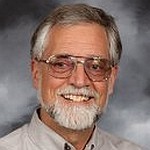 The A. E. Seaman Mineral Museum was the featured exhibitor at the 69th Annual Greater Detroit Gem, Mineral and Fossil Show held at the Macomb Community College Expo Center and hosted by the Michigan Mineralogical Society. The show theme was “marvelous metals” and a photo of one component of the museum’s native copper exhibit was on the program.
The A. E. Seaman Mineral Museum was the featured exhibitor at the 69th Annual Greater Detroit Gem, Mineral and Fossil Show held at the Macomb Community College Expo Center and hosted by the Michigan Mineralogical Society. The show theme was “marvelous metals” and a photo of one component of the museum’s native copper exhibit was on the program.
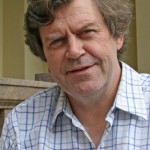 GMES Seminar: Linking mantle dynamics to plate tectonics
GMES Seminar: Linking mantle dynamics to plate tectonics
Trond H. Torsvik, Centre for Earth Evolution and Dynamics (CEED), University of Oslo, 0316 Oslo, Norway; Friday, November 1, 2013, Dow 610
The calibration of longitude in the mid-eighteenth century by the invention of a sea-going chronometer gave mariners confidence that they could reliably calculate their absolute position on the Earth’s surface. Until recently, Earth scientists have been in the comparable position of having no way of calculating the longitudes of continents before the Cretaceous, leaving paleomagnetism, which cannot determine longitude, as the only quantitative means of positioning continents on the globe before that time. However, by choosing a reference continent that has moved the least longitudinally (i.e. Africa), longitudinal uncertainty can be minimized. The analytical trick is to rotate all paleomagnetic poles to Africa and calculate a global apparent polar wander path in African co-ordinates, which serves as the basis for subsequent global reconstructions. This method is dubbed the ‘zero-longitudinal motion’ approximation for Africa, and has allowed us to confidently estimate true polar wander (TPW) since Pangea formation (320 Ma), and to demonstrate that ancient large igneous provinces and kimberlites have been sourced by plumes from the edges of the large low shear-wave velocity provinces (LLSVPs) on the core-mantle boundary beneath Africa and the Pacific. Using this surface-to-CMB correlation and a new iterative approach for defining a palaeomagnetic reference frame corrected for TPW, we have developed a model for absolute plate motion back to earliest Paleozoic time that maintains the remarkable link between surface volcanism and the LLSVPs. For the Paleozoic we have for the first time identified several phases of slow, oscillatory TPW (less than 1 degree/Myr) during which the Earth’s axis of minimum moment of inertia was similar to that of Mesozoic times. We model ten phases of clockwise and counter-clockwise rotations since 540 Ma, which can be interpreted as oscillatory swings approximately around the same axis (11 degrees East at equator). Net TPW angles peaked at 22 degrees in the Mesozoic and 62 degrees in the Paleozoic, and paleomagnetic and TPW-corrected (mantle) reconstructions therefore differ significantly in the early Paleozoic.
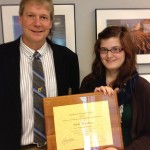 Neala Creasy, a Senior in Applied Geophysics in the Geological and Mining Engineering & Sciences Department at Michigan Tech 2014 – Women of Promise award.
Neala Creasy, a Senior in Applied Geophysics in the Geological and Mining Engineering & Sciences Department at Michigan Tech 2014 – Women of Promise award.
The Women of Promise program was initiated in 1999 as a result of a recommendation from the Presidential Council of Alumnae (PCA). The program recognizes current female Michigan Tech students from each academic department who go above and beyond what is expected of them in terms of being a well-rounded student, by demonstrating, for example, academic achievement, campus and community leadership, good citizenship, creativity, and other characteristics of high achieving individuals. In short, women who exemplify, early on, the criteria one would consider in selecting future inductees to the Presidential Council of Alumnae. This program is also an excellent opportunity for current female students to interact with and often to be mentored by successful Michigan Tech Alumnae.
The 2013 GMES winner was Audrey L. Hutton.
Three Michigan Tech students won scholarships at the Association of Environmental and Engineering Geologist (AEG) 56th Annual Meeting in Seattle.
Lauren Schaefer, a geology PhD student, won the Tilford and Lemke scholarships. The Tilford scholarship is provided to a graduate student for field studies. The Lemke scholarship is provided for outstanding student abstract for the work, “Geotechnical characterization of materials for stability analysis of large volcanic slopes: Are studies for specific volcanoes justifiable?” Lauren is advised by Thomas Oommen (GMES).
To the people of Peña Blanca, Panama, Chet Hopp must seem like a godsend. He’s helping them get cleaner water, improve sanitation and understand their local volcanic hazards.
“I’m an environmental health extensionist, which means that my main responsibilities to my community of Peña Blanca deal with sanitation,” says Hopp, a Peace Corps Master’s International student in geology at Michigan Technological University. “Specifically, we work to improve access to potable water through development and construction of gravity-fed aqueducts, as well as improving sanitation practices through education and access to various types of latrines.”
MORE
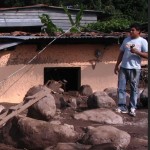 Soil around San Vicente volcano in El Salvador has always been rich, leading farmers to plant coffee, beans and sugar cane on its slopes. In times of heavy rain, the loose soil and volcanic rock on the steep slopes washes down, covering the villages nearby in heavy mud.
Soil around San Vicente volcano in El Salvador has always been rich, leading farmers to plant coffee, beans and sugar cane on its slopes. In times of heavy rain, the loose soil and volcanic rock on the steep slopes washes down, covering the villages nearby in heavy mud.
Find out more about the work of John Gierke and Luke Bowman in the article published in Environmental Monitor
Remote Sensing and Hazard Modeling Workshop Video
Taller de Sensores Remotos y Modelacion de Amenazas en El Salvador